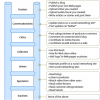Sabine also showed that there’s a need to go beyond the 1-90-100 law of participation by pointing [to] the “participation ladder” described by Forrester Research:[above]
For brands, this is important and as much as 25% of the content of brands are made of UGC. Technology converted part of the “spectators” into users, which in turn can prescript products and services (only 14% of consumers trust ads, 78% trust recommendations from friends and family). However, ad men seem to have a love and hate relationship with UGC. They know it can lead to success and consumers’ engagement but they fear the inherent loss of control. The advantage for brands are clear: create a relationship with people, develop a certain proximity, favor adhesion and recommendation, etc. The risk to loose control is there but it was already present beforehand.
What’s interesting is that design can produce gaps and holes that people can fill. These gaps can lead to new form of dialogues between companies and the users of their products.
(via Pasta&Vinegar » Blog Archive » Lift seminar at imaginove abt User-Generated Content)
There is also a passage on User Generated Content (UGC) in the videogame industry in the original post.
